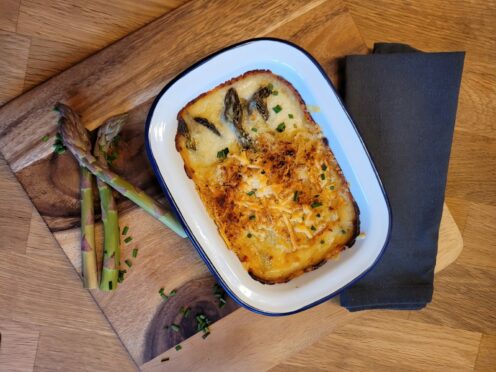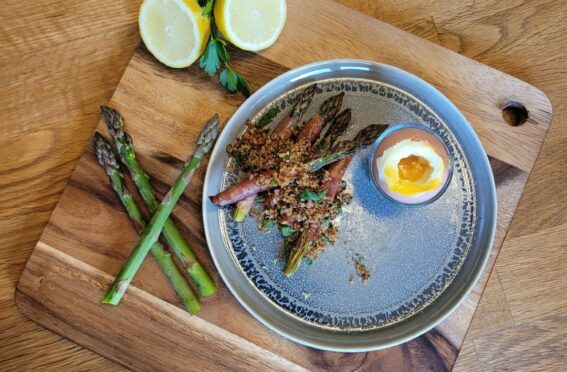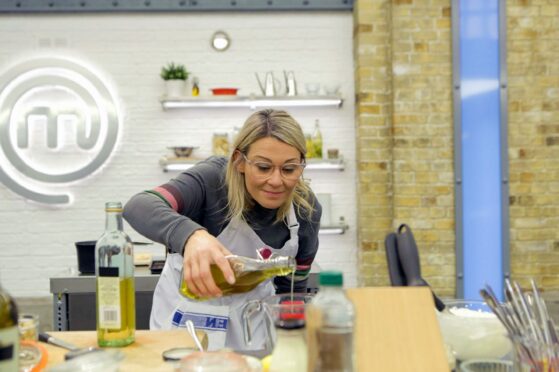Inverness-born Sarah Rankin is a Perthshire-based home cook and MasterChef finalist. She champions the best recipes, producers and makers in her new monthly A Scottish Larder.
The Scottish asparagus season is glorious, but fleeting. These little spears of delight grow quickly but are really only available in May and June so do not delay. Gorge yourself while you can.
Spring has sprung and summer appears at least to be on its way. Cue packing in salads, rose and alfresco dining. Interspersed, of course, with the obligatory Scottish summer standard of two days per week of plummeting temperatures, jumpers and sausage hotpot.
Let us celebrate however, as our “blink and you’ll miss it” asparagus season is here.
A versatile vegetable with an iron-rich taste, asparagus lends itself particularly well to eggs. It’s good for you too. A comforting thought, especially when you’ve slathered it in a rich hollandaise or an oozy, bubbling cheese gratin.
Asparagus is high in folate/Vitamin b9, which can help to fight fatigue, as well as Vitamin C and thiamine which support immune health and heart function. My advice is to focus on that, while adding an extra grating of Parmesan and a glug of double cream.
Simple asparagus is best
In my view asparagus is best served simply, allowing its delicious freshness to shine through. Prep by snapping off the woody ends.
Just hold firmly horizontally and gently bend, it’ll snap naturally in the right place. You can trim off a very fine outer layer of the stalk if you’re being fancy, but this is not essential.
Then pop them in boiling salted water turned down to a simmer (these are delicate creatures) for no more than four minutes, depending on their thickness.
When they turn a bright green, they’re ready. I like to plunge them into iced water if I’m doing something else with them, as it’ll help to keep that beautiful, vibrant green.
Otherwise, season with flaked salt and devour.
Go Cheesy!
For a delicious side or lunch dish, prep your spears and lay in an ovenproof dish. Cover in a cheese sauce made by melting butter, adding some plain flour, whisking in warmed milk and stirring until thick. Season it well with salt, white pepper and a grating of nutmeg, then add a couple of handfuls of grated strong, hard cheese.
A quality Scottish cheddar is a good place to start, but my current favourite for this job is Smoked Anster. A crumbly and delicately smoked cheese from the St Andrews Farmhouse Cheese Company. A nutty gruyere would work equally well, however.
Pour the sauce over your spears, being careful not to submerge them entirely, and sprinkle another handful of grated cheese mixed with breadcrumbs over the top. Cook at 180C/160 Fan/350F/Gas Mark 4 for about 15 to 20 minutes and finish under a high grill for another two minutes to brown the top.
Delicious with a large hunk of crusty bread and a green salad or as a side with some poached salmon.
A brunch delight
For an inventive brunch idea, wrap your asparagus in prosciutto crudo or streaky bacon, pop into the oven at 180C/160 Fan/350F/Gas Mark 4 for 10 minutes and in the meantime, soft boil a large egg to the almost fudgy stage (about 6-7 minutes) and use your asparagus and ham soldiers for dunking.
Sprinkling a quick gremolata over the top of the spears will elevate this to dizzy heights of deliciousness, with a crunchy, garlicky punch. Simply whizz up some leftover crusty bread (or use some panko breadcrumbs), toast in a pan with butter and half a clove of grated garlic. Once beautifully golden, add the zest of half a lemon and a couple of tablespoons of chopped parsley. Sprinkle that liberally over your ham-encased spears.
A duck egg works even better as there’s more of that yolk to go around and the extra richness is an absolute delight. Add a minute or so to your cooking time to account for the difference in size. Little tip, always store your eggs at room temperature and to cook, gently drop them into boiling water, then turn down to a simmer.
If you are one of those strange beings who doesn’t like asparagus (we can never be friends), then you can substitute tenderstem broccoli soldiers instead.
Get friendly with cordial
While we’re on the subject of summer peering around the corner, I’m currently messing around with cocktails as we attempt to venture outdoors for post-work libations.
Anything drunk outside in the sunshine has a certain added cachet, even if you have to put on a fleece halfway through.
A few years ago, I discovered the Hugo, an Austrian invention that’s found throughout Switzerland, Germany and the South of France. Made by muddling a few mint leaves with elderflower cordial, adding a shot of gin and topping off with a mix of soda and prosecco. I tend to add in a good squeeze of lemon juice too. Just a sip of one of these and you’ll be transported to sunnier climes.
During lockdown, I had a go at making my own elderflower cordial and was pleasantly surprised at how easy it was. We have loads of elders in our garden. Mainly due to our appalling approach to gardening which generally involves, “ignore it and if it survives, it belongs there”.
Make it
To make elderflower cordial, pick the blooms when flowering, usually late May to late June.
Try and pick them with as little stem as possible to allow for regrowth. The stems need to be checked carefully for tiny bugs which like to live there so carefully brush off any lodgers before using. Many recipes call for dunking the heads in water to remove bugs but I think that can take away much of the flavour. So if you can, try and remove them without water.
For about 20 or so large heads you’ll need 1kg of granulated sugar, 1.5 litres of water and a large pan. Swirl over a low heat and add the juice and zest of two lemons. Once the sugar has dissolved, turn off the heat and add the flower heads. Cover and leave for 24 hours, stirring a couple of times. Strain though a muslin or clean tea towel and decant into jars or bottles.
Make sure you’ve sterilised the jars first by washing them and covering in water in a pan.
Bring to the boil and let simmer for 10 minutes. Remove carefully when cooled a little, add the cordial and seal.
This will keep happily in the fridge for about four weeks. As well as a fantastic cordial and cocktail base, it is delicious poured over lemon sorbet to make a quick granita.




